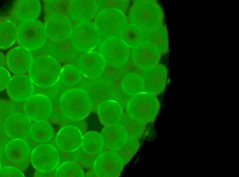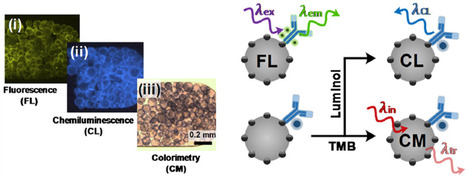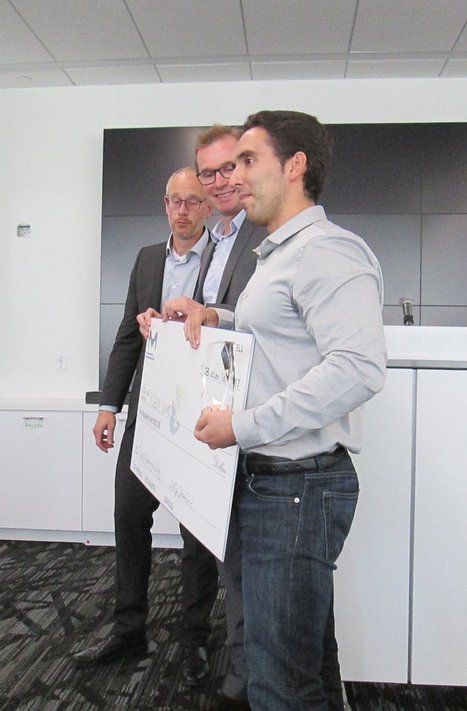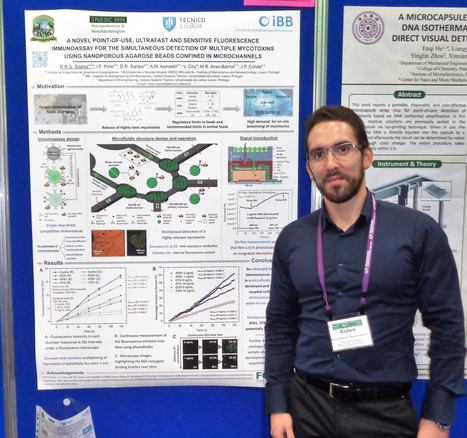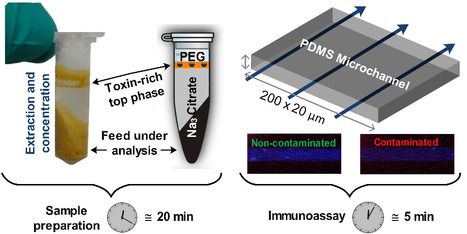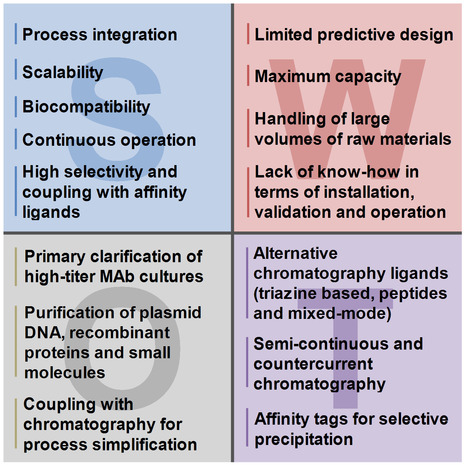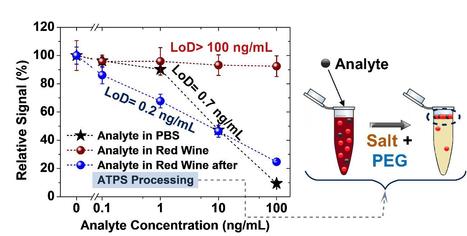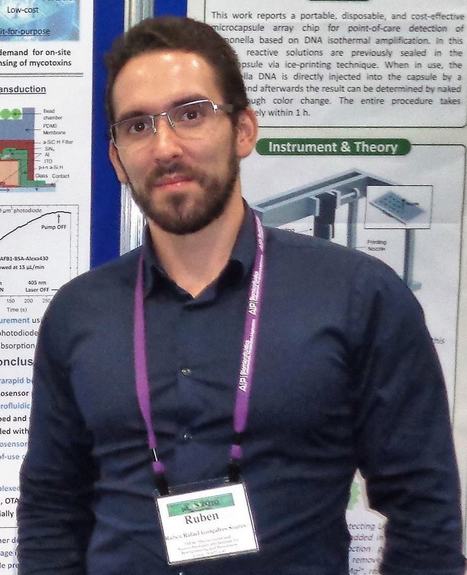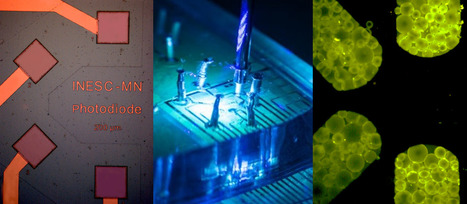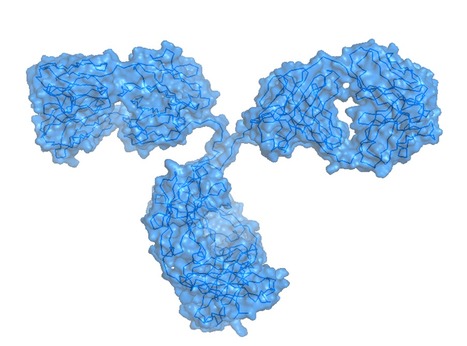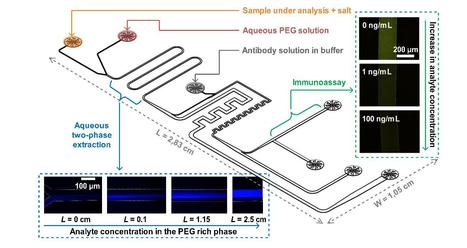 Your new post is loading...
 Your new post is loading...

|
Scooped by
iBB
July 30, 2019 6:59 AM
|
Optimizing the Performance of Chromatographic Separations Using Microfluidics
The establishment of novel, simpler and improved purification processes is extremely important to make antibody-based treatment options more accessible and with a lower economic burden to healthcare systems and patients. In this context, the development of microfluidic tools for the optimization of chromatography operating conditions can offer advantages such as low consumption of molecules, fast generation of results and ability to automate and multiplex the assays. In a collaboration between INESC-MN and iBB, researchers have recently reported a novel microfluidics-based methodology to perform rapid and multiplexed screening of various chromatography ligands relative to their ability to bind different target molecules in solution. The work was published in the Biotechnology Journal and is expected to contribute to the fields of separation sciences and analytical chemistry and inspire new developments within the purification of biopharmaceuticals or other molecules.

|
Scooped by
iBB
February 6, 2019 12:39 PM
|
Bead-based Microfluidic Platform for DNA Hybridization
The demand for portable, rapid, sensitive and low-cost DNA detection systems that could be used for rapid diagnostic of disease and infection has motivated the development of new DNA detection platforms in recent years. BERG-iBB researchers working with colleagues from INESC-MN report a rapid and simple bead-based microfluidic platform to detect a specific 22-mer DNA sequence via hybridization, serving as a model of a miRNA biomarker for tumor and cardiovascular diseases. Nanoporous chromatography beads were used as solid support for probe DNA immobilization. The lowest limit of detection of 9.5 pM was achieved with an assay time of 10 min using a quantum dot label coupled with a multi-mode immobilization. The results highlight the potential of the system as a simple DNA hybridization platform, that achieves low pM sensitivities without the need for DNA amplification. The work was published in Sensors and Actuators B.

|
Scooped by
iBB
June 5, 2018 10:22 AM
|
Quantitative Analysis of Bead-Based Microfluidic Optical Biosensors
Microfluidic devices with integrated photodetectors can address the need for compact and portable biosensing platforms for medical, veterinary, environmental and food safety applications. However, depending on the application, performance requirements like the minimum detectable limits, the target sensitivity, and the detection time can vary dramatically. To improve the engineering of fit-for-purpose bead-based microfluidic biosensors, researchers at BERG-iBB and INESC-MN developed a simple quantitative methodology to determine (1) equilibrium constants, (2) binding kinetics, (3) rate at which photons are generated/absorbed per captured molecule, and (4) molecular capture efficiencies. These parameters provide an effective trade-off between required sensitivity, cost effectiveness and assay complexity. This work was published in the IOP Journal of Micromechanics and Microengineering.

|
Scooped by
iBB
October 20, 2017 2:40 PM
|
Ruben Soares Wins Merck Life Science Award in Food and Beverage Safety
Ruben Soares, a PhD student at INESC MN and BERG-iBB has won the Merck Life Science Award in Food and Beverage Safety for his work on Microfluidic Platforms for Mycotoxin Detection. Ruben was selected from 4 finalists at the award ceremony that took place in Burlington, MA, USA on 17-18 October. Congratulations Ruben!

|
Scooped by
iBB
September 16, 2017 10:33 AM
|
Ruben Soares, a PhD student at INESC MN and BERG-iBB has been selected as one of 4 finalists in the Merck Life Science Food and Beverage Safety Award for the work he is doing for his PhD thesis on Microfluidic Platforms for Mycotoxin Detection. As a finalist, Merck will pay for Ruben to travel to Burlington, MA, USA on 17-18 October for the award ceremony where one of the finalists will be selected to receive the award. Click on title to learn more about the award.

|
Scooped by
iBB
July 17, 2017 4:53 AM
|
Researchers at BERG-iBB and INESC-MN recently published a simple and versatile sample preparation methodology based on a green aqueous two-phase system for the simultaneous extraction and concentration of mycotoxins in multiple feeds, which are currently among the most relevant and widespread contaminants in the food and feed industry. This method was tailored for the subsequent rapid detection of ochratoxin A, aflatoxin B1 and deoxynivalenol at the relevant limits within the ng/g range, using a microfluidic multiplexed chemiluminescent immunoassay. Overall, sample preparation and detection were achieved in about 25 min using a “point-of-need” compatible process. Click on title to learn more.

|
Scooped by
iBB
June 2, 2016 3:48 AM
|
In a collaboration with the start-up company Lumisense, researchers at IBB and INESC MN have recently published an innovative biosensor to detect the mycotoxin ochratoxin A in foods and feeds, within the scope of the European project DEMOTOX ( http://www.demotox.it/). By performing a chemiluminescent competitive immunoassay within 200x100 µm disposable microchannels and acquiring light with a photosensor, it was possible to obtain quantitative results in less than 5 min. This type of device shows great potential for the rapid, on-site mycotoxin screening, a highly demanded feature to assure food safety and effectively enforce EU regulations. Click on title to learn more.

|
Scooped by
iBB
July 31, 2015 9:14 AM
|
For half a century aqueous two-phase systems (ATPSs) have been applied for the extraction and purification of biomolecules. In spite of their simplicity, selectivity, and relatively low cost they have not been significantly employed for industrial scale bioprocessing. Recently their ability to be readily scaled and interface easily in single-use, flexible biomanufacturing has led to industrial re-evaluation of ATPSs. Researchers of the Bioseparation Engineering Laboratory at BERG-iBB together with Dr. James V. Alstine, a former principal scientist at GE Healthcare recently published a review in the Biotechnology Journal providing a new perspective over aqueous two-phase separations focusing on the strengths, weaknesses, opportunities and threats to this separation technique with an industrial perspective.

|
Scooped by
iBB
September 24, 2014 5:06 AM
|
|

|
Scooped by
iBB
April 11, 2019 12:19 PM
|
Effect of Fluorescent Tags on Rapid Screening of IgG Partition in PEG-salt ATPS
Rapid empirical optimization/screening of the partition of biomolecules in aqueous two-phase systems (ATPS) can be performed in microfluidic devices coupled with fluorescence microscopy. However, the effect of fluorescent tags on partition must be carefully evaluated to assess the validity of extrapolating the results to a situation where the molecules are unlabelled. To evaluate this influence, researchers from BERG-iBB and INESC-MN (Mariana São Pedro, Ana Azevedo, Maria Raquel Aires-Barros and Ruben Soares) carried out an ATPS study using both microtubes (batch) and microfluidic devices (continuous). IgG molecules were labelled with three fluorescent tags with different global charge and reactivity, namely BODIPY™ FL maleimide, Alexa Fluor® 430 NHS ester and BODIPY™ FL NHS ester. The thiol reactive BODIPY™ FL maleimide coupled with a reducing agent provided minimal bias relative to the native molecule in PEG-phosphate systems. The work was recently published in the Biotechnology Journal.

|
Scooped by
iBB
October 8, 2018 10:45 AM
|
Rúben Soares Defends PhD Thesis in Biotechnology and Biosciences
Rúben Soares will be defending his PhD thesis in Biotechnology and Biosciences at Instituto Superior Técnico, monday the 15th October 2018 (10:00 H, room PA3). During the last years, and under the supervision of Profs. João Pedro Conde from INESC-MN and Raquel Barros from BERG-iBB, Rúben worked on the development of several miniaturized modules (analyte preparation, immunodetection, optical transduction and portable eçlectronics) of a portable point-of-need mycotoxin screening chip. The title of his thesis is "Development of integrated microfluidic mycotoxin screening chip for point-of-need food safety applications”.

|
Scooped by
iBB
May 21, 2018 10:13 AM
|
Sub-minute Detection of Multiple Food Contaminants With a Lab-on-a-chip Device
The 3-fold increase in global population within the last 70 years implies a demand for an equally fast paced global food trade. Thus, to assure high food safety standards and protect the consumers, simple, rapid and effective means of screening food contaminants are required to adequately enforce regulations. Towards this goal, researchers at BERG-iBB and INESC MN recently developed a lab-on-a-chip microfluidic device with integrated photodetectors, allowing the simultaneous immunodetection of three harmful fungal toxins in a single step, in less than one minute and at concentrations in the parts-per-billion range. The work was published in the Royal Society of Chemistry journal Lab on a Chip.

|
Scooped by
iBB
October 5, 2017 3:53 AM
|
Optimization of chromatography is a lengthy and demanding task that requires large volumes of reagents and costly equipment. Ana Azevedo and colleagues from BERG-iBB, in collaboration with João Pedro Conde from INESC-MN, describe an integrated, reusable and portable microfluidic platform for the rapid screening of chromatographic conditions. The platform was tested for the capture of fluorophore-labeled monoclonal antibodies from cell culture supernatants using a multimodal ligand (Capto MMC). The work is part of Inês Pinto´s PhD thesis in Biotechnology and Biosciences. Click on title to leran more in the journal Sensors and Actuators B.

|
Scooped by
iBB
September 1, 2017 1:05 PM
|
The use of aqueous two-phase extraction (ATPE) is a viable option for the purification of antibodies and other vluable proteins, but these systems are difficult to model and optimize. In a publication in the Journal of Chmoratography A, researchers at BERG-iBB and INESC-MN describe a methodology for the rapid screening of antibody extraction conditions that relies on a microfluidic channel-based toolbox. A first microfluidic structure allows a simple negative-pressure driven rapid screening of up to 8 extraction conditions simultaneously, using less than 20 μL of each phase-forming solution per experiment, while a second microfluidic structure allows the integration of multi-step extraction protocols based on the results obtained with the first device. Click on title to learn more.

|
Scooped by
iBB
September 21, 2016 1:40 PM
|
Researchers at INESC MN and BERG-iBB recently published the development of a microfluidic device to simultaneously screen a panel of toxins in multiple samples. This interdisciplinary work combines biochemistry, physics and materials engineering to (1) generate a reproducible array of 9 discrete immunosensing regions in an area of 0.12 mm2, (2) achieve the required sensitivities and (3) integrate an array of microfabricated Si photoconductors to acquire the signal of each discrete region. This type of device holds promise towards the rapid screening of key harmful mycotoxins in foods and feeds, assuring an effective enforcement of EU regulations. Click on title to learn more.

|
Scooped by
iBB
October 20, 2015 12:18 PM
|
Virus-like particles (VLPs) are promising candidates for a new generation of biopharmaceuticals. In a recent publication in the Journal Separation and Purification Technology, BERG researchers led by Raquel Aires-Barros and working in collaboration with INESC-MN and the company Icosagen (Estonia) describe a microfluidic system for the recovery of HIV-like particles from cell supernatants by aqueous two phase extraction. The system features 100 width × 20 μm wide microchannels and continuous pumping of the two immiscible phases. The results obtained show that it is possible to carry out extraction under miniaturized conditions. This opens up the possibility for the set up of a highthroughput microfluidic platform for the screening of optimal extraction conditions for the recovery of biologicals. Click on title to learn more. Photo details: SEM micrograph of HIV particles infecting a human H9 T cell. NIAID 2009, PD, Wikimedia commons.

|
Scooped by
iBB
October 1, 2014 3:58 PM
|
A joint publication of researchers from BERG-iBB and INESC-MN in the journal Lab-On-a-Chip describes a new method of integrating a liquid sample preparation step based on aqueous two-phase systems in continuous with an immunoassay. This was performed in microfluidic channels with a depth of 20 µm, four times thinner than the average human hair. The strategy allows simultaneous neutralization of matrix interferents, analyte concentration and detection in a single step, thus having great potential for rapid and sensitive point-of-need applications without the need for complex sample preparation procedures. The work was performed in the context of Ruben Soares's PhD in Biotechnology (supervisors R Aires Barros, JP Conde). Click on the title to learn more.
|
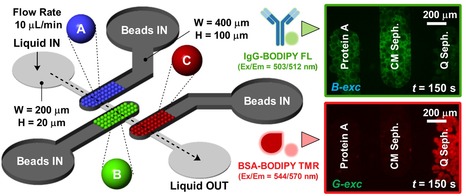



 Your new post is loading...
Your new post is loading...


